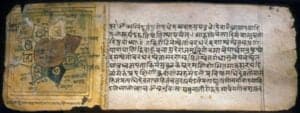If you’re a Tantra Geek like me, you have read, or have attempted to read, the ancient texts of the Tantrik traditions. As beautiful, profound and fascinating as these texts called “tantras” can be, they present a number of interpretive problems for sincere, contemporary students.
Yesterday, I published a post about the use of hyperbole in Tantrik teaching texts and how to relate to said hyperbole. Today, I am sharing with you some thoughts on the use of “twilight language” in the production of the ancient Tantras.


Many important tantras have been lost, or exist only in fragments, or as fragmentary quotes in later texts. Surviving tantras are often written in sāndhyābhāṣā, or “twilight language.”
Sāndhyābhāṣā literally means “speech in the gap.” Sāndhi is a gap, juncture or boundary. Ābhāṣā means speech or saying and is closely related to another word, abhāsā (same word without the dot under the “s”), that means “an appearing.”
Everything we experience, including ourselves, is an abhāsā, or appearing of primordial, unconditioned consciousness and energy. The appearings that comprise manifest life issue from the speech of the primordial Shakti. There is a primordial vibration emanating from consciousness that gives rise to sound forms and then to experiences of worlds, beings and things. Everything we experience, including our own bodies, is said to be visible sound.
Abhāsā also has the connotation of something brilliant, colorful, or even glamourous. The appearings of God, aka the totality of manifest life, are said to be the glamour or magic of God. Just look around, and you will see this glamour everywhere.
Sāndhyābhāṣā is a method of writing in which the essence of a teaching appears in the gap between the words on the page.
A Guru writing in sāndhyābhāṣā purposely scrambles the text, leaves out key instructions, or writes incorrect instructions such as false mantras, so that the text can only correctly “appear” when the Guru transmits the full teaching orally. This ensures that teachings are given only to qualified students working closely with their teacher.
I have experienced a living example of this method of preserving the teachings as an oral tradition. When I first moved to Portland, Oregon, I lived for a year with a young Tibetan couple. An accomplished, elderly yogini would sometimes come and give teachings in our house. Her speciality was Chöd, a practice introduced into Tibet by the woman teacher Machig Lapdrön in the 11th century.
My roommates invited me to participate in the teachings even though I could not speak or read Tibetan. The yogini, myself and several generations of female Tibetan students would crowd into a small puja room. The only contribution I could make was to ring the bell as mantras were offered. I did get to drink out of a human skull, though. Which was cool.
The words of the Chöd practice were printed in traditional Tibetan books comprising long, narrow strips of paper. However, the pages were deliberately out of order. Only the yogini knew the true order of the practice. I watched as the students moved from one page to another, out of sequential order, following the oral instruction of their teacher.
Relying on the precise, oral instructions of a teacher affords students the best chance of gaining the fruit of sadhana and ensures the correct transmission of the teachings from generation to generation.
At the same time, even if you have an ancient text that is presented correctly, it is an exceedingly rare person who can read the text and do the practices described in the best way with the correct View and feeling-orientation (bhava). It is hard enough to do that when you have a living teacher!
Furthermore, the fruit of every practice whether it be mantra, or anything else, unfolds in stages, generally over a long time. No book describes all of these stages, and no one can show you how to unfold a practice in the best way without having done years, if not decades or lifetimes of unfolding themselves.
It is true that some rare individuals have deep connections with a tradition of practice and can receive transmission from texts. But transmission is the beginning of the job of waking up. You work with the transmission through diligent practice; the transmission does not do all of the work for you. Even those people who are reincarnations of excellent yogis and Gurus must learn from teachers and practice with sincerity and consistency over many years.
As Anandamayi Ma often said, shastra (scriptures) are maps; they are not the territory.
If you are walking through a landscape, you see many things along the way that are not on the map of the same road. The teacher’s job is to walk with you, orienting you to what is important and pointing out how to continue without getting stuck, stumbling too badly or going off track altogether.
It is always best to receive teachings orally from someone who has realized the teachings in themselves and can therefore guide you through every stage. If you cannot find a teacher right now, try to find contemporary books that are written by teachers who have many years of experience and whose intention is to explain how to do practice in a way that modern people can understand.
I have found it useful, when possible, to study the oral teachings of modern masters. We now have the happy situation in which some teachings have been recorded and transcribed, or even filmed. For instance, a lot of the teachings of my Satguru, Anandamayi Ma, have been recorded, transcribed and translated. If you understand Bengali, you can listen to her teachings in audio recordings. The teachings of a modern siddha of Trika Shaivism, Swami Lakshmanjoo, are available in many formats including books, audio and video.
Studying the ancient Tantras is important for understanding traditions more deeply, for being inspired and learning correct View, but we should be cautious if we use them as sources of information about how to practice.

